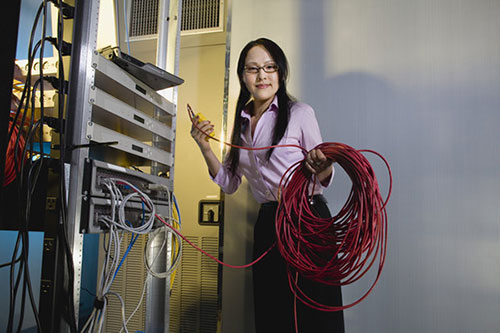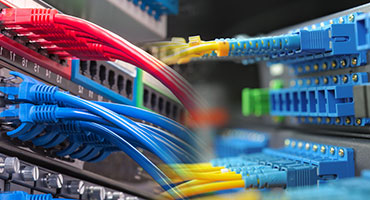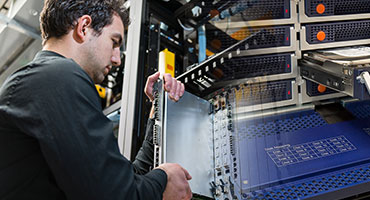6 steps for setting up a server room for your small business
Are you worried about relying on a third-party online service provider to store your business data? Learn how to set up your own server room for an on-premises deployment instead.

NOTE: This story was originally published in September 2013 and updated in April 2017.
Bringing IT in-house and setting up dedicated on-premises servers can be intimidating for a small business, especially given the recent focus on online services. Moreover, resources designed to help tend to assume a medium-sized or enterprise installation, which may not necessarily work well for setting up a small server room or even a closet for a branch office.
With some understanding of the basics, though, setting up your own server room for your small business network need not be an arcane process. Here are some tips for getting started.
Rack-mount equipment makes sense
It's not uncommon for small businesses to begin operation by stacking server hardware and network appliances on a desk or shelf. Though such a deployment is inexpensive, the pile of equipment invariably expands into an unmanageable mess with the growth of the company. Exposed equipment is also completely open to physical tampering and is a ticking time bomb for accidents such as coffee spills, dust or even workers tripping over wires.
However, rack-mount equipment is designed specifically to properly house this type of hardware. While these tend to be pricier than their non-rack-mount equivalents, it's arguable that being easier to manage far exceeds the cost premium. In addition, shelves and drawers designed for mounting onto the server rack are widely available; these let racks work with non-rack mount appliances as necessary.
There's a server rack for all seasons
Before getting the server rack, it's good to first understand its basic characteristics. Server racks are measured in terms of rack units, usually written as "RU" or simply "U." One rack unit equals 1.75 inches (44.45mm) in high, with compliant equipment measured in multiples of "U." Network switches are generally 1U to 2U, servers can range from 1U to 4U and blade servers can be anywhere from 5U to 10U or more.
Consider, too, the width and depth of the server rack, which is generally accepted to be 19 inches for the former and 600mm to 1,000mm for the latter. Some server racks come with adjustable rear brackets, though most rack mount servers come with adjustable mounting kit that can be used as long as there's sufficient depth for the server.
The most common commodity server rack today is probably the four-post rack designed to hold servers and appliances 19 inches wide. A typical full-height rack measures 42U; half-height equates to 24U. Other options exist, including desktop variants that range from 5U to 20U. (These measurements don't pertain to the external dimension of the rack; that varies depending on design.) Optional caster wheels can be handy for limited mobility.
Two alternatives for space-constrained locations are open frame racks or small wall-mounted cabinets. Keep in mind, though, that open frame racks may have special mounting requirements, such as being bolting to the floor, while wall-mounted cabinets may not be suitable for loads heavier than network switches or just a few servers.
Isolate servers to reduce noise
Organizations without the luxury of a dedicated room for server equipment will want to consider noise management. Whenever possible, a small, partitioned room is worth the expense. Aside from substantially dampening or even eliminating productivity-sapping equipment noise, having a room for your server gear also offers the ability to secure IT equipment against casual theft or tampering.
In small businesses, where there's no option but to place your rack in the corner of the room or within the IT department itself, racks with sound-dampening properties are highly recommended. Since air vents make complete soundproofing impossible, these racks are generally measured by their noise-reduction properties. How well they work is a combination of the noise generated the one's equipment and the overall sound-reduction capabilities of the rack itself.
Beat the heat and get an AC unit (or two)
If all you plan to deploy is a couple of network switches and a five-bay network attached storage (NAS) system, then you probably don't need to worry about cooling. Pack in several more servers, a mid-sized uninterruptible power supply and a larger NAS, though, and the heat starts building up quickly. Needless to say, high temperatures can dramatically shorten equipment life and often culminate in inexplicable crashes or outages.
It's possible to compare the thermal load of the rack with the thermal output of your server equipment, but a common-sense approach of measuring the temperature inside the rack is often sufficient. Keeping your equipment cool isn't isolated to the heat dissipation capabilities of your server rack; it's also directly affected by the ambient temperature outside the rack. That's why installing air-conditioning units in the server room is recommended.
One often-overlooked concern is what happens when servers remain on after office hours. In such scenarios, you'll need a separate air-conditioning unit that's not tied to the building's central air unit, which is typically switched off after a certain hour. Ideally, businesses should install two standalone units in the room, on separate circuit breakers, for redundancy. This also allows them to be alternated regularly for servicing.
Proper cable management (see next section) also helps ensure proper ventilation. Generally, it's not a good idea to cram 42 1U servers into a full-height rack. Not only does this create cabling constraints, older server chassis may need 1U to 2U of space between each other to ensure adequate airflow. (Most modern rack-mount servers don't need such spacing.)
Managing wires isn't glamorous, but it's necessary
Setting up a server rack is more than just twisting a few screws to secure the equipment into place. Proper cable management can't be overstated, as just about every piece of equipment in the rack is linked with Ethernet cables. Intra-cabinet wiring aside, it makes sense to terminate cable runs for Ethernet LAN points for desktop computers, IP cameras and other network appliances at the rack.
The best way to properly manage all these cables is to use an RJ45 patch panel to terminate Ethernet cable runs. The typical patch panel installs in 1U of space and offers up to 24 ports. Using a patch panel does require some hands-on work — stripping a cable, punching it into the patch panel and using a wire tester tool to verify the connectivity. (If hiring a professional is in the budget, he or she can probably get everything installed in less than a day.)
In addition to a patch panel, always have a bag of cable ties handy to easily secure stray cables. Standard cable ties are "throwaway" cheap when purchased in bulk, though releasable ones that can be reused aren't that much more expensive.
Label everything — and keep it simple
Finally, don't skimp on labeling and documenting your setup, even for relatively simple deployments. What may be obvious to the employer setting it up could be missed by a new IT staffer or a vendor contracted to work on certain aspects of the system. Time savings aside, proper labeling reduces the likelihood of catastrophic mistakes such as a mission-critical system getting unplugged or restarted without adequate warning.
The simplest way to properly label your infrastructure? Purchase a label printer from a hardware shop. Servers and network appliances should be labeled with unique descriptive names and their IP addresses. Ditto for other equipment such as keyboard, video and mouse switches, NAS appliances, routers, data backup devices and redundant hardware.
Detailed notes describing important procedures relating to your on-premises hardware should be printed out and attached to the server cabinet with tape or refrigerator magnets. These notes should important operating instructions relating to networking, data backup or shutting down (or starting up) the equipment in the event of a power outage.




